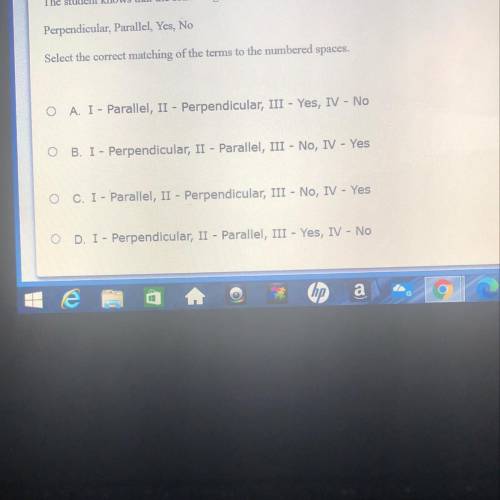
Physics, 08.11.2020 02:20 meganwintergirl
A student is creating a flowchart of effective questions that compares and contrasts the characteristics of electromagnetic and mechanical waves. The student knows that the
questions at the top of the flow chart will help distinguish waves that are electromagnetic from waves that are mechanical, as seen in the bottom of the flowchart.
Which direction are
Does the wave require
particles displaced in
a medium to travel?
IV
The evidence indicates this is The evidence indicates this is
The student knows that the following terms should appear in the spaces indicated by I, II, III, and IV.
Perpendicular, Parallel, Yes No
Select the correct matching of the terms to the numbered spaces.


Answers: 1
Another question on Physics

Physics, 22.06.2019 04:30
You are traveling in a car going at a constant speed of 100km/h down a long, straight highway. you pass another car going in the same direction which is traveling at a constant speed of 80km/h. as measured from your car's reference frame this other car is traveling at −20km/h. what is the acceleration of your car as measured from the other car's reference frame? what is the acceleration of the other car as measured from your car's reference frame?
Answers: 2

Physics, 22.06.2019 04:30
In a system, when potential energy decreases, then entropy also decreases. true false
Answers: 2

Physics, 22.06.2019 10:30
Awoman holds a book by placing it between her hands such that she presses at right angles to the front and back covers. the book has a mass of m = 1.8 kg and the coefficient of static friction between her hand and the book is μs = 0.67. no attempt 50% part (a) what is the weight of the book, fgb in newtons?
Answers: 3

Physics, 22.06.2019 14:40
During the experiment if you could triple the breakaway magnetic force with all other quantities left unchanged, what is the new value for the critical velocity if it was v0 (initial velocity), initially? (b) now if you halved the radius with all other quantities left unchanged, what is the new critical velocity if it was v0 (initial velocity), initially? (c) if during the experiment, critical velocity quadrupled with all other quantities left unchanged, what is the new breakaway force if its magnitude was initially f0,?
Answers: 1
You know the right answer?
A student is creating a flowchart of effective questions that compares and contrasts the characteris...
Questions



Mathematics, 29.11.2019 01:31


Mathematics, 29.11.2019 01:31

Mathematics, 29.11.2019 01:31





Mathematics, 29.11.2019 01:31

Mathematics, 29.11.2019 01:31

Mathematics, 29.11.2019 01:31


Social Studies, 29.11.2019 01:31


Mathematics, 29.11.2019 01:31


Mathematics, 29.11.2019 01:31




